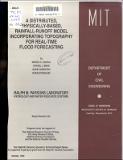A Distributed, Physically-based, Rainfall-runoff Model Incorporating Topography for Real-time Flood Forecasting
Author(s)
Cabral, Mariza C.; Bras, Rafael L.; Tarboton, David; Entekhabi, Dara
Download23741858.pdf (11.33Mb)
Metadata
Show full item recordAbstract
We present a distributed, physically-based model of runoff generation in a catchment, for operational use in flood forecasting. The model accounts for both the infiltration-excess and saturation-excess mechanisms of runoff production, and for lateral subsurface flows. The effect of local terrain slope on subsurface flows and the development of areas of saturated soil is accounted for. The model uses spatial discretization into rectangular elements which correspond to the grid of a Digital Elevation Map. Each basin element consists of a soil column in which hydraulic conductivity decreases with depth, in the form of an exponential function. Spatial discretization allows for distributed terrain slope, soil parameters, moisture conditions, and rainfall inputs. Time discretization allows for consideration of time-variable rainfall rates. The model uses the kinematic approximation of infiltration and subsurface flows, which are assumed to occur only within the porous soil matrix. The kinematic model of infiltration is used to show how decreasing conductivity with depth may result in the development of a zone of perched saturation during a rainstorm, and that the flow in the perched saturated zone is diverted laterally if the terrain is inclined. A simplified computational procedure is introduced that allows flow transfer among elements. Inter-element flow transfers are used to predict the position of the permanent water-table in each element at the time of initiation of the rainfall event and the extent of the area of saturated soils. Moisture transfer between elements during the storm is also considered. The model is extended to consider anisotropic soils, and we show that higher lateral than vertical conductivity results in increased lateral diversion of flow. The model was applied to the Sieve catchment in Italy and used to reproduce hydrographs for 12 recorded rainstorms. Given that pre-storm baseflow was not available for any of the 12 storms, three different water-table positions were considered for each storm, low average and high, corresponding to steady-state equilibrium with the baseflow values that have a 90% and 10% probability of being exceeded in the month in question. The observed hydrographs for the various storms were, generally, in the area comprised between the "dry" and "wet predicted hydrographs, or did not fall far from this area. Given the scarcity of data available for the Sieve, we consider model predictions to be quite encouraging.
Description
Research partially supported by the Arno Project of the National Research Council of Italy through a cooperative agreement with the University of Florence, Italy and the Ralph M. Parsons Foundation. Research partially supported by the U.S. Army Research Office grant DAAL0-3-89-K-0151. Research partially supported by the National Science Foundation grant CES-8815725. Research partially supported by the National Weather Service cooperative agreement NA86AA-D-HY123.
Date issued
1990-10Publisher
Cambridge, Mass. : Ralph M. Parsons Laboratory, Hydrology and Water Resource Systems, Massachusetts Institute of Technology, Dept. of Civil Engineering
Other identifiers
332
Series/Report no.
R (Massachusetts Institute of Technology. Department of Civil Engineering) ; 90-21.Report (Ralph M. Parsons Laboratory for Water Resources and Hydrodynamics) ; 332.